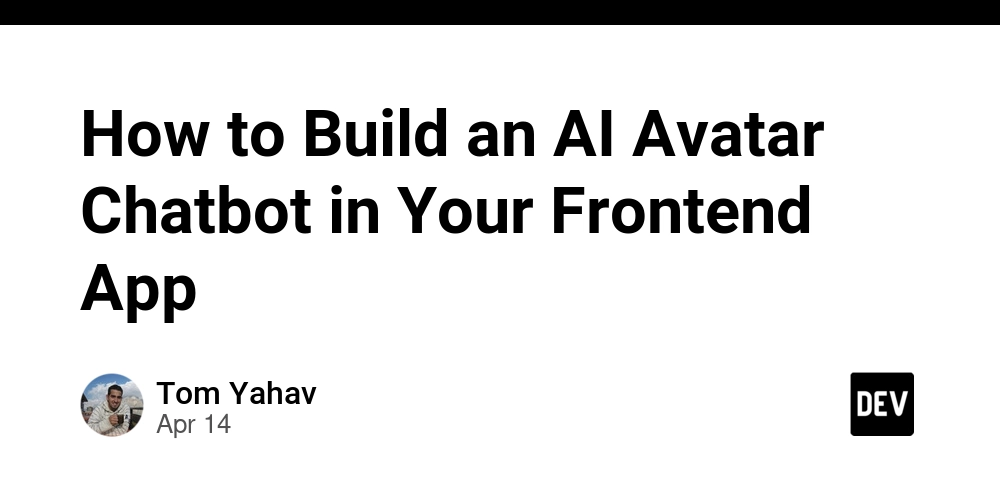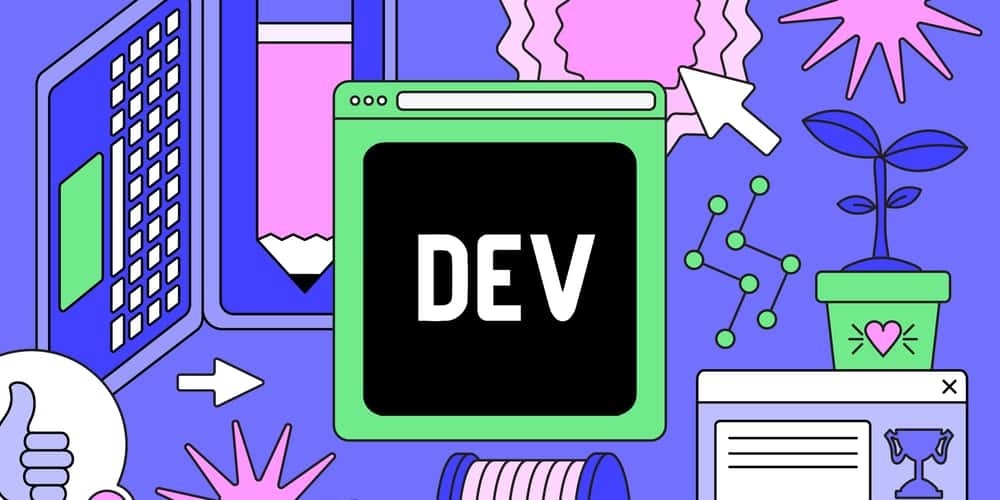How to Build an AI Avatar Chatbot in Your Frontend App
Introduction & Context AI chatbots are no longer just functional—they can be expressive, voice-enabled, and visually engaging. In this tutorial, you'll learn how to build an AI-powered chatbot in a Vue 3 app that not only talks like ChatGPT, but also has a visual avatar that reacts to the conversation. This is perfect for use cases like virtual tutors, onboarding assistants, storytelling characters, and customer service bots. Goals and What You’ll Learn By the end of this article, you’ll know how to: Integrate OpenAI’s GPT model for conversational logic Build a frontend chat UI with avatars and dynamic expressions Use the Web Speech API for text-to-speech (TTS) Animate avatar emotions based on message sentiment Enhance UX for accessibility and user delight Project Overview We’ll build: A chat interface An animated avatar (using CSS or Lottie) A voice synthesizer to read AI replies Tech Stack Vue 3 + Composition API OpenAI GPT API (gpt-3.5-turbo) Web Speech API (TTS) Tailwind CSS or basic CSS for styling Optional: Lottie animations for expressive avatars Step 1: Setup Your Vue 3 Project npm create vite@latest ai-avatar-chatbot -- --template vue cd ai-avatar-chatbot npm install npm install axios Add your API key to .env: VITE_OPENAI_API_KEY=your_openai_api_key_here Step 2: Create the Chat Interface import { ref, watch, nextTick } from 'vue' import axios from 'axios' import LottieAvatar from './LottieAvatar.vue' const userInput = ref('') const messages = ref([]) const chatContainer = ref(null) const lottieAvatar = ref(null) const speak = (text) => { const synth = window.speechSynthesis const utter = new SpeechSynthesisUtterance(text) lottieAvatar.value?.play() utter.onend = () => { lottieAvatar.value?.stop() } utter.onerror = (event) => { console.error('SpeechSynthesisUtterance.onerror', event) lottieAvatar.value?.stop() } synth.speak(utter) } const sendMessage = async () => { if (!userInput.value.trim()) return const prompt = userInput.value messages.value.push({ role: 'user', content: prompt }) userInput.value = '' try { const res = await axios.post( 'https://api.openai.com/v1/chat/completions', { model: 'gpt-3.5-turbo', messages: [...messages.value, { role: 'user', content: prompt }] }, { headers: { Authorization: `Bearer ${import.meta.env.VITE_OPENAI_API_KEY}` } } ) const aiReply = res.data.choices[0].message.content messages.value.push({ role: 'assistant', content: aiReply }) speak(aiReply) await nextTick() chatContainer.value.scrollTop = chatContainer.value.scrollHeight } catch (err) { console.error('Error sending message:', err) messages.value.push({ role: 'assistant', content: 'Oops, something went wrong.' }) lottieAvatar.value?.stop() } } AI Assistant {{ msg.content }} Send /* Add custom scrollbar styles for WebKit browsers (Chrome, Safari) */ .overflow-y-auto::-webkit-scrollbar { width: 8px; } .overflow-y-auto::-webkit-scrollbar-track { background: #f1f1f1; border-radius: 10px; } .overflow-y-auto::-webkit-scrollbar-thumb { background: #d1d5db; /* Tailwind gray-400 */ border-radius: 10px; } .overflow-y-auto::-webkit-scrollbar-thumb:hover { background: #9ca3af; /* Tailwind gray-500 */ } /* Add some basic scrollbar styles for Firefox */ .overflow-y-auto { scrollbar-width: thin; scrollbar-color: #d1d5db #f1f1f1; /* thumb track */ } Optional: Use Lottie for Avatar Animation To add expressive animations instead of static avatar images, you can use Lottie, a lightweight animation library. Step 1: Install lottie-web npm install lottie-web Step 2: Download an animation JSON file Get a character animation from lottiefiles.com, for example a talking face or blinking robot. Place it under public/animations/ai-avatar.json. Step 3: Create a reusable LottieAvatar.vue component import { onMounted, onUnmounted, ref } from 'vue' import lottie from 'lottie-web' const container = ref(null) let animationInstance onMounted(() => { animationInstance = lottie.loadAnimation({ container: container.value, renderer: 'svg', loop: true, autoplay: true, path: '/animations/ai-avatar.json' }) }) onUnmounted(() => { if (animationInstance) animationInstance.destroy() }) Step 4: Replace the static image in your main chat UI import LottieAvatar from '@/components/LottieAvatar.vue' Optional: Dynamically switch Lottie animations If you want to show different moods: watch(mood, (newMood) => { animationInstance?.destroy() animationInstance = lottie.loadAnimation({ container: container.value, renderer: 'svg',

Introduction & Context
AI chatbots are no longer just functional—they can be expressive, voice-enabled, and visually engaging. In this tutorial, you'll learn how to build an AI-powered chatbot in a Vue 3 app that not only talks like ChatGPT, but also has a visual avatar that reacts to the conversation.
This is perfect for use cases like virtual tutors, onboarding assistants, storytelling characters, and customer service bots.
Goals and What You’ll Learn
By the end of this article, you’ll know how to:
- Integrate OpenAI’s GPT model for conversational logic
- Build a frontend chat UI with avatars and dynamic expressions
- Use the Web Speech API for text-to-speech (TTS)
- Animate avatar emotions based on message sentiment
- Enhance UX for accessibility and user delight
Project Overview
We’ll build:
- A chat interface
- An animated avatar (using CSS or Lottie)
- A voice synthesizer to read AI replies
Tech Stack
- Vue 3 + Composition API
- OpenAI GPT API (gpt-3.5-turbo)
- Web Speech API (TTS)
- Tailwind CSS or basic CSS for styling
- Optional: Lottie animations for expressive avatars
Step 1: Setup Your Vue 3 Project
npm create vite@latest ai-avatar-chatbot -- --template vue
cd ai-avatar-chatbot
npm install
npm install axios
Add your API key to .env:
VITE_OPENAI_API_KEY=your_openai_api_key_here
Step 2: Create the Chat Interface
Optional: Use Lottie for Avatar Animation
To add expressive animations instead of static avatar images, you can use Lottie, a lightweight animation library.
Step 1: Install lottie-web
npm install lottie-web
Step 2: Download an animation JSON file
Get a character animation from lottiefiles.com, for example a talking face or blinking robot. Place it under public/animations/ai-avatar.json.
Step 3: Create a reusable LottieAvatar.vue component
Step 4: Replace the static image in your main chat UI
Optional: Dynamically switch Lottie animations
If you want to show different moods:
watch(mood, (newMood) => {
animationInstance?.destroy()
animationInstance = lottie.loadAnimation({
container: container.value,
renderer: 'svg',
loop: true,
autoplay: true,
path: `/animations/${newMood}.json`
})
})
Now your chatbot can visually react using Lottie-based animations!
Use a library like lottie-web to play animations like nodding, blinking, or reacting.
npm install lottie-web
Then embed dynamic animations instead of static images.
Accessibility & UX Enhancements
- Use aria-live="polite" on the chat area
- Add keyboard accessibility for sending messages (Enter key)
- Use voice only when user allows (ask permission)





























![[Webinar] AI Is Already Inside Your SaaS Stack — Learn How to Prevent the Next Silent Breach](https://blogger.googleusercontent.com/img/b/R29vZ2xl/AVvXsEiOWn65wd33dg2uO99NrtKbpYLfcepwOLidQDMls0HXKlA91k6HURluRA4WXgJRAZldEe1VReMQZyyYt1PgnoAn5JPpILsWlXIzmrBSs_TBoyPwO7hZrWouBg2-O3mdeoeSGY-l9_bsZB7vbpKjTSvG93zNytjxgTaMPqo9iq9Z5pGa05CJOs9uXpwHFT4/s1600/ai-cyber.jpg?#)










































































































































![[The AI Show Episode 144]: ChatGPT’s New Memory, Shopify CEO’s Leaked “AI First” Memo, Google Cloud Next Releases, o3 and o4-mini Coming Soon & Llama 4’s Rocky Launch](https://www.marketingaiinstitute.com/hubfs/ep%20144%20cover.png)





























































































































![[FREE EBOOKS] Machine Learning Hero, AI-Assisted Programming for Web and Machine Learning & Four More Best Selling Titles](https://www.javacodegeeks.com/wp-content/uploads/2012/12/jcg-logo.jpg)








































































![Rogue Company Elite tier list of best characters [April 2025]](https://media.pocketgamer.com/artwork/na-33136-1657102075/rogue-company-ios-android-tier-cover.jpg?#)








































































_Andreas_Prott_Alamy.jpg?width=1280&auto=webp&quality=80&disable=upscale#)






























































































![What’s new in Android’s April 2025 Google System Updates [U: 4/18]](https://i0.wp.com/9to5google.com/wp-content/uploads/sites/4/2025/01/google-play-services-3.jpg?resize=1200%2C628&quality=82&strip=all&ssl=1)










![Apple Watch Series 10 Back On Sale for $299! [Lowest Price Ever]](https://www.iclarified.com/images/news/96657/96657/96657-640.jpg)
![EU Postpones Apple App Store Fines Amid Tariff Negotiations [Report]](https://www.iclarified.com/images/news/97068/97068/97068-640.jpg)
![Apple Slips to Fifth in China's Smartphone Market with 9% Decline [Report]](https://www.iclarified.com/images/news/97065/97065/97065-640.jpg)




































































































































